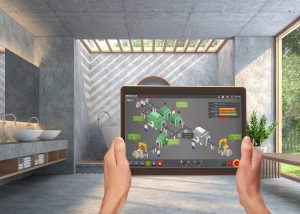For a renowned Turkish manufacturer of bathroom and sanitary ceramics looking to enhance its production with a modern supervisory system, the implementation of Movicon SCADA delivered improved management of the production process and played a key role in enabling the company to guarantee final product quality.
While home potters and smaller pottery businesses tend to rely on raw glazes for product finishing and decoration, larger ceramics operations tend to prefer ‘frits’ to overcome production problems and imbue their products with specific characteristics. A frit is a ceramic compound that has been fused, quenched, and granulated to provide a source of oxides to create a glaze. Applied well, frits ensure a good quality firing with few defects, even clarity, smooth surface and bright colours.
Any oxide provided as a frit will offer superior qualities than simply using the raw material of that oxide as a glaze. So, although more expensive, the benefits of using frits outweighs the costs. However, the production of frits and the mixing of them to deliver the specific properties required for a given application is a precision operation.
Frits are produced from a combination of raw materials such as barium oxide, strontium oxide, lithium oxide, zinc oxide, sodium oxide, calcium oxide and magnesium oxide, fused into a vitreous or semi-vitreous substance. The process involves mixing the raw materials and firing them in special kilns, then grinding the mixture into a fine powder. The precise mixing of different levels of compounds can provide a defined melting point, expansion properties, gloss, resistance to leaching, hardness, colour, etc, as required for a given ceramic product application.
It is this need for precision in the production of the frits, and the number of different recipes involved in making the individual compounds that led the manufacturer to look at implementing an enhanced supervisory system. To meet its needs, it turned to Movicon SCADA from Progea, which is represented in the UK by Products4Automation.
The company’s plant has 21 silos for storing raw materials, each is equipped with valves, motors and sensors, and there are load cells to monitor the consumption of the raw materials. In the first section of the plant, the raw materials for a given frit recipe are batched, mixed and transferred to one of four kiln silos. After production, the second section of the plant contains a further six silos for the packaging of the frits. The loading and packing system is automatic, with the frits packed into bags in several different sizes.
Process automation within the plant extends from the MES system at the higher level of the enterprise, through the Movicon SCADA system, to an Omron PLC which provides plant floor control. The PLC communicates with the Movicon SCADA over Omron’s FINS ethernet-based protocol.
At the mixing stage the Movicon SCADA monitors, in real time, the powder quantities and ensures the correct compound is delivered to the kilns. Load cells are used to check the weight of each material against the recipe to guarantee a perfect final mixture.
However, the perfect mix is dependent on not only the right quantities of each raw material, but also on the order of entry into mixture and the specific mixing time. All these elements of the recipe are stored in a database. Operations are executed within the MES system, with the processes and the overall production schedule managed and supervised from within the Movicon SCADA.
When the mixture is ready it is transported to the kilns, where Movicon monitors and records time, temperature and humidity values. These can be exported in reports to be reviewed by production managers to check that the production process is within tolerances for assured product quality.
While quality assurance was the main reason for the implementation of Movicon SCADA, a number of other important benefits have also been realised. First among these was the provision of ‘one-click operation’ for batch production, combined with intuitive operator interface screens and comprehensive alarms and error reporting to make it easy to see when and where a problem might have arisen. Further, the reporting system makes it easy for production managers to access information on production costs and production quantities, providing a mechanism for driving-up efficiency.
Perhaps one of the greatest benefits of Movicon SCADA is its scalability, which provides a simple route for the operator to upgrade additional processes or incorporate further elements into the plant as required, without major changes to the existing SCADA system.
Finally, the manufacturer has reported a reduction in downtime at the plant, with Movicon SCADA providing continuous and comprehensive monitoring of the production line.






